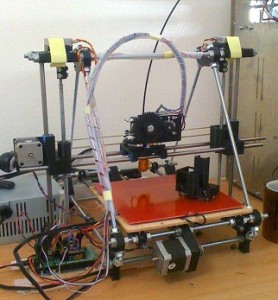Thermoplastic Extrusion, or TPE, is an additive manufacturing method that is very similar to FDM, and has become one of the most widely used 3D printing technologies. TPE is used in a wide variety of 3D printers, many of which are hobbyist or do-it-yourself systems.
Probably the most famous representative of the TPE 3D do-it-yourself printer class is the RepRap Mendel 2 – an attempt to create a self-replicating manufacture machine. Since the RepRap uses thermoplastic extrusion (of which plastic is the raw material) to print, and since RepRap itself is mostly composed of plastic parts, the RepRap should be able to replicate itself.
Of course, fully-assembled and commercial 3D printers using thermoplastic extrusion technology exist as well. Top-of-the-line commercial 3D printers are able to print much better parts than cheap hobbyist ones.
The Basic Thermoplastic Extrusion Process:
- An STL file containing information about the printed part’s cross-sections is loaded into the 3D printer’s software.
- The extrusion nozzle is then heated until it’s hot enough to melt thermoplastic – the material used in TPE printing.
- Once it’s hot enough, either a thin plastic filament from a coil or plastic pellets from a hopper are fed through an extrusion nozzle.
- The nozzle “draws” a slice of printed part on a platform, depositing molten plastic in the form of the part’s cross-section while moving in horizontal and vertical directions. As plastic gets squirted from the nozzle, it cools and hardens, bonding to the layer below.
- Once the cross-section is finished, the nozzle “draws” another one on top of it. This process is repeated until the whole part is finished.
Here’s a video of a RapMan 3.2 3D printer at work, using a version of TPE 3D printing:
It’s worth nothing that while the principle of the process stays the same, there may be minor differences – for instance, in high-end systems, the printing process goes inside the chamber heated to just below the melting point of the plastic – which provides better control over the process. Cheaper TPE 3D printers, on the other hand, use just a heated table.
The process may also require supports – however, they are usually easily removed.
While TPE machines use only one class of materials – thermoplastic – there is certain variety within that class. Some materials like ABS have decent strength, while others, like polycarbonate, provide better temperature tolerance.
Thermoplastic extrusion 3D printers are able to quickly print small or tall and thin parts, and the surface is quite smooth. Accuracy and detail is also fairly good, at least for the more expensive machines. However, for hobbyist printers accuracy may suffer. The printing process is also slow when a large or wide part has to be printed, and layer-to-layer adhesion may suffer in the cheaper models.
All in all, TPE 3D printers offer a wide range of solutions: from inexpensive hobbyist printers that are slow, inaccurate and print parts with poor finish to higher-end machines that offer good surface finish and are much faster and more accurate. The TPE raw materials are relatively cheap, and printer operation is quiet and clean.


Comments are closed, but trackbacks and pingbacks are open.